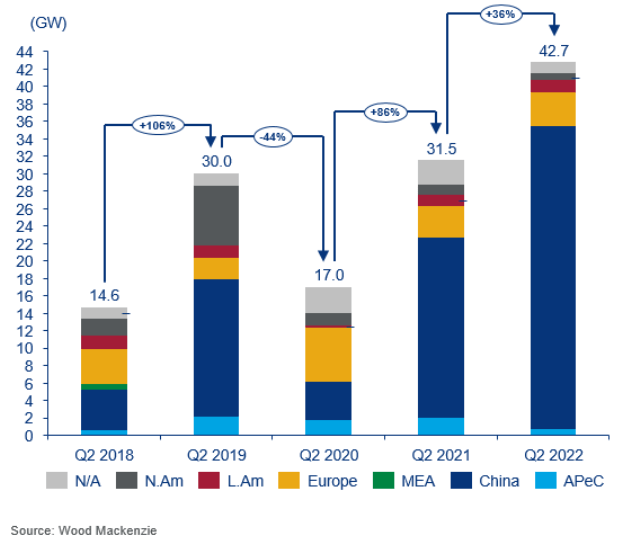Global wind turbine order intake surged 36 percent to 43 GW in Q2 2022 to $18.1 billion, a new record, thanks to strong activity in China, according to Wood Mackenzie.
China aims to support an estimated average build of more than 55 GW per year over the next 10 years. In Q2, China accounted for a record 35 GW of activity and is at 45 GW year-to-date.
Europe showed growth for order intake with 3.8 GW, doubling its Q1 activity. Order intake activity in the US remained slow, with less than 2 GW through H1.
The global order intake for offshore wind exceeded 6 GW in Q2 of this year. This is only the third time offshore orders have exceeded that number. Developers in the Chinese market galvanized the largest ever H1 firm orderbook for the offshore wind sector, comprising 74 percent global offshore order capacity. Offshore order intake in China has now increased consecutively for three quarters, following a nearly year-long lull.
“Goldwind, Mingyang and Envision were all active in Q2 with projects in China, accounting for more than 26 GW of activity between them,” said Luke Lewandowski, Wood Mackenzie Research Director.
Seven Chinese turbine OEMs – with Envision, Mingyang, and Goldwind in the first three positions – recorded enough firm order capacity to rank in the global top 10 for order intake through the first half of 2022.
Buoyed by China, global activity is on a record pace through the first two quarters of 2022, with 61 GW ordered. This is 13 percent higher than H1 2021 and is the highest half-year ever recorded.
Demand is sluggish in the US due to tough market conditions, such as labor cost increases, inflation and supply chain disruptions. As a result, securing new orders in the US has been difficult, which has had a negative impact on OEMs dependent on the market, primarily Western-based OEMs.
Wood Mackenzie anticipates a boost in activity over the second half of the year with the passage of the IRA bill in the US. With these new incentives, wind power projects have become more economically viable and thus more competitive compared to conventional technologies.

